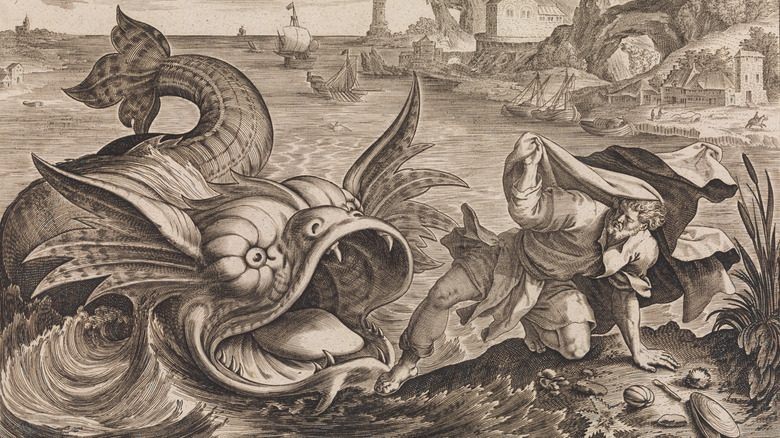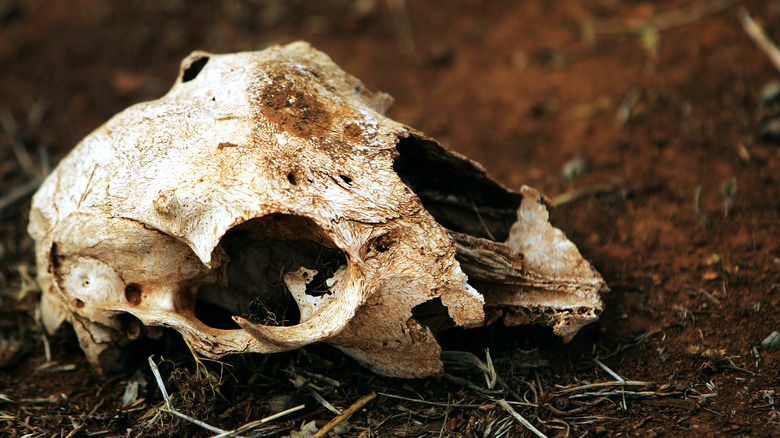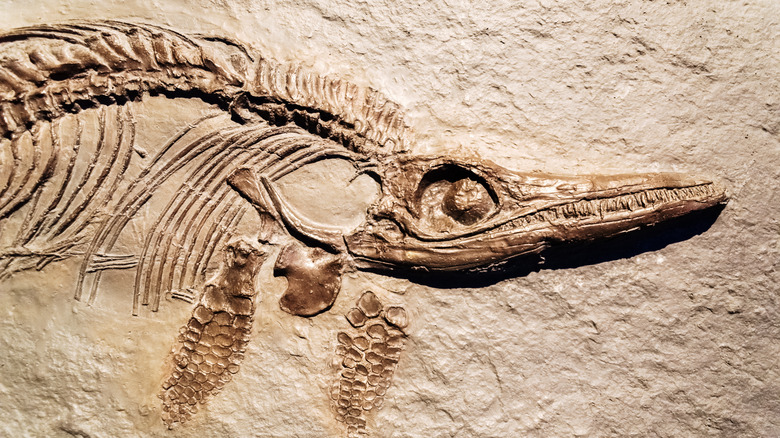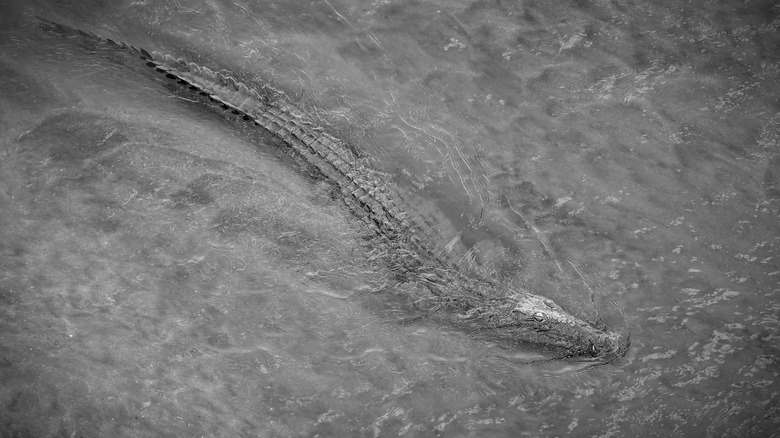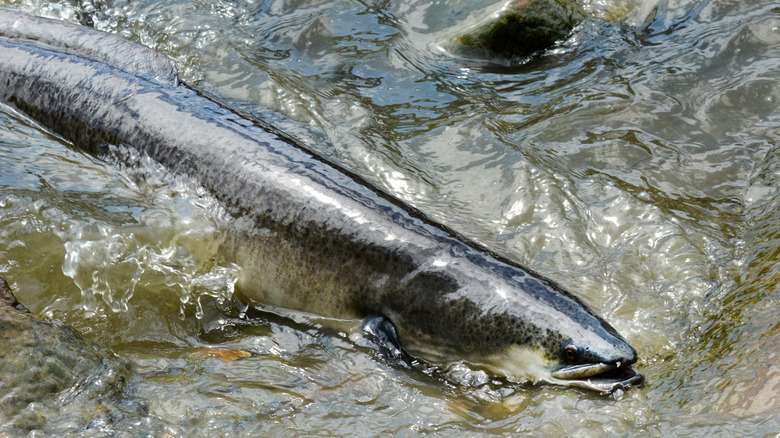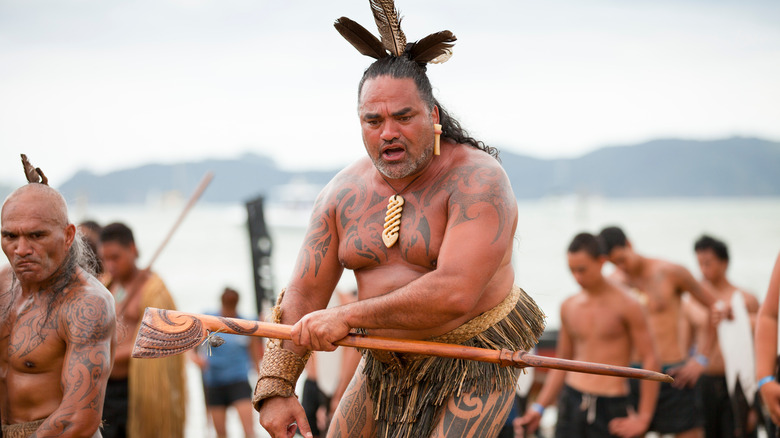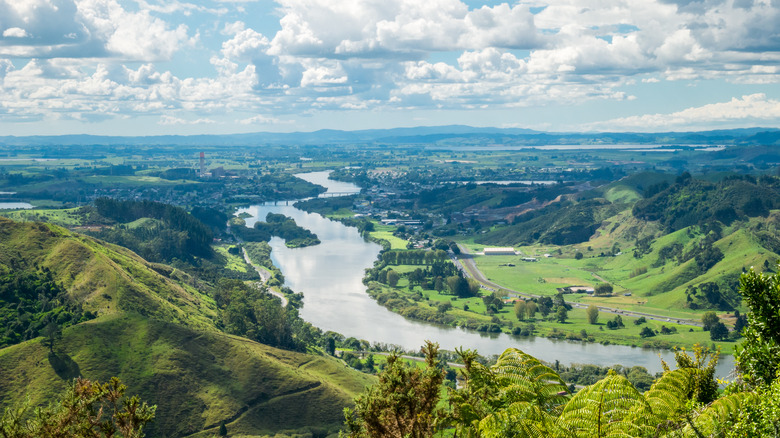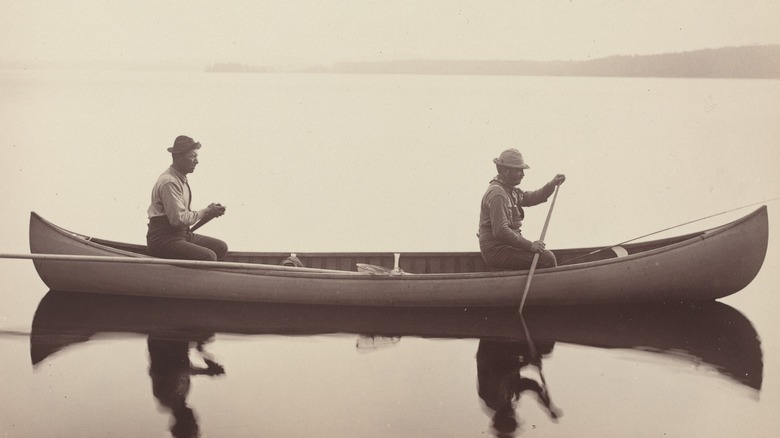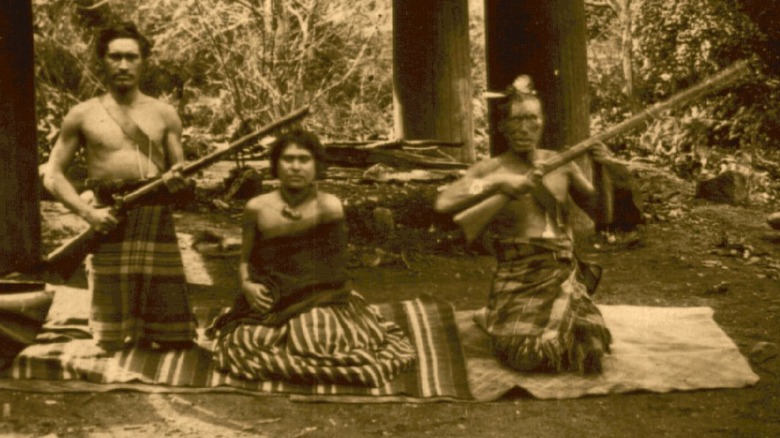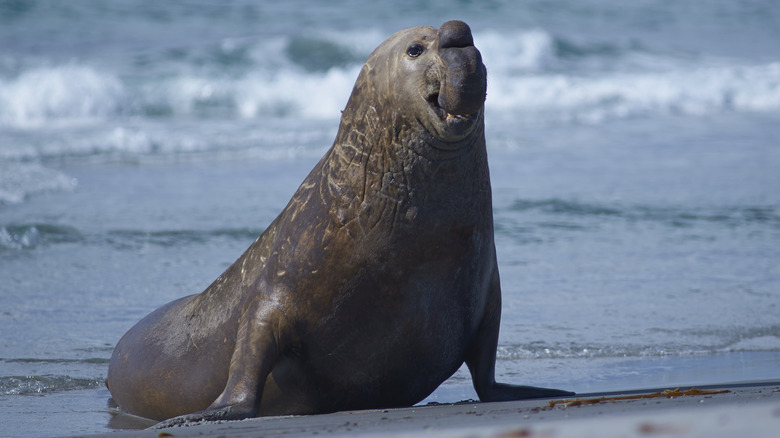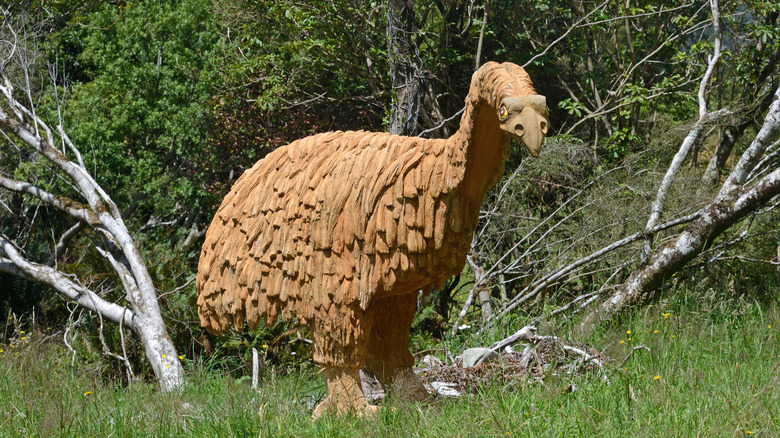The Monster That Terrorized New Zealand In The 1880s
The idea of ferocious unknown creatures lurking on land and sea stretches back to the earliest days of exploration, and you don't have to look far to find these legends worldwide. Among pre-modern cultures, the prevalence of fantastic beasts doesn't prove surprising. Humans have always had exceptional imaginations, and superstitious generations further elaborated on each tale, crafting entertaining and terrifying epics along the way. But when it comes to the late 19th century, you might assume sightings of legendary monsters started to fall away.
After all, science had gained a significant foothold in the world, so it would only make sense that individuals would abandon irrational myths and legends, right? Not necessarily. As it turns out, the late 1800s ushered in an avalanche of cryptid sightings (via the Library of Congress). Chief among these was the so-called "saurian monster," which terrorized New Zealand in the 1880s. Why the uptick in sightings? Ironically, many people wholeheartedly accepted the existence of unknown beasts, and they assumed science would confirm, rather than debunk, them.
Contemporary discoveries, including those of marine reptile fossils, bolstered the existence of these monsters in some people's minds. It wasn't a far stretch for scientists to assume these creatures still existed. As reported by Forbes, Charles Lyell himself posited that "animal species don't go extinct, but can survive in inaccessible regions of the world, like the deep sea." And when it came to "inaccessible regions of the world," few geographical areas fit the bill like 1880s New Zealand.
1880s New Zealand represented the final frontier
As of April 1881, New Zealand boasted a non-native population of 489,933, according to Statistics New Zealand. Five years later, the nation reached a significant milestone. For the first time in its history, the non-Maori population living on the island was predominantly native rather than immigrant-born.
Yet, despite campaigns to bring in more women, young males continued to dominate the population, and many longed for a taste of one of the world's final frontiers. The rustic island continued to have trouble attracting women and families, although local governments tried various schemes, as reported by NZ History. Starting in 1879, New Zealand experienced an economic depression, the result of governmental debt incurred in the 1870s. Unemployment spiked, and many individuals moved away, attracted by the bright lights of Australia.
Although silver linings existed, such as the first successful exportation of meat to Great Britain on ice, a financial recovery wouldn't take hold until the 1890s. That said, the nation's frontier remained pregnant with possibility as explorers continued pushing into its impenetrable terrain. Along the way, unexplained sightings emerged.
A gruesome discovery in New Zealand
Into this climate of growing pains came a fascinating story that placed the world's attention on New Zealand. It contained all of the intrigue and suspense of an excellent cryptid tale: strange sightings, local legends, and, eventually, physical evidence.
In 1886, slaughter yard employees made a gruesome discovery near Hamilton, New Zealand, in the Waikato region, as reported by Atlas Obscura. Something had removed a sheep carcass from the meat hook where it hung. The sheep's remains were picked clean of all flesh without explanation. Beyond the defleshed creature, few clues remained at the scene. No hair samples where the thieving animal had brushed against a fence post or tree existed, and it left behind no dung to study and analyze. But locals did find a trail of unidentifiable footprints. Speculation soon gripped the nation as whispers of an aquatic reptilian monster emerged.
On October 1, these whispers entered the public record as the New Zealand Herald ventured an account of the mysterious happenings, beginning with the understatement, "This creature's appearance has created quite a sensation." Despite the lack of clues, some locals quickly latched onto sensational conclusions about the incident. Men armed up, ready to hunt the strange creature. Based on scant evidence left by the so-called monster, some New Zealanders claimed it pointed to "undoubted traces of a saurian monster," as reported by Atlas Obscura.
Hyped up headlines stoke local fears about the so-called 'saurian monster'
What did they mean by a "saurian monster"? According to Atlas Obscura, the term refers to a "lizard-like" creature — in other words, anything from a crocodile to a reptilian cryptid. Interestingly, science may have contributed to the hysteria. How? According to researchers Darren Nash and Charles G.M. Paxton, the discovery of new marine reptile fossils appeared to inspire upticks in 19th-century reports of sea monsters.
Reports also morphed to reflect the latest scientific finds. As reported by Forbes, Nash and Paxton concluded that, "Especially after 1850, the classic sea serpent is replaced by the long-necked sea serpent featuring four or more fins and a prominent neck, a feature visible in the skeletons of mosasaurs and especially plesiosaurs."
But New Zealand had a severe credibility problem when it came to "saurian monster" claims. Of the 110 lizard species native to the country, all fall into two reptilian families: geckos and skinks (via Te Ara). These reptiles rarely surpass half a foot. How could one grow large enough to remove and devour a sheep carcass suspended from a meat hook? The Waikato Times wrote, "CROCODILE OR WHAT? To be sure, the idea of a crocodile making his way unobserved from warmer latitudes across the ocean and taking up his residence in the vicinity of Hamilton is very laughable" (via Timespanner).
On the lookout for the saurian monster
Sightings of the saurian monster exploded. One of the most famous reports came from a farm in Hamilton owned by Mr. Castleton, per the New Zealand Herald on October 1, 1886. According to his wife, the first of their sons to spot the strange creature got chased by it to the house. When the boy finally reached the house, she thought he might faint from sheer panic. But that wasn't the last encounter.
According to Mr. Castleton, his sons had a second experience with the creature as it swam by in the river. The boys had kept watch for the animal ever since the initial chasing incident and "were standing at a spot whence they could see a large stretch of the creek, and again observed a commotion in the water, and saw the creature swimming down the creek, its head alone being above water."
In the article, Constable Wild expressed complete faith in the boys' account. The Herald also refuted claims by other newspapers that the boys had witnessed something else, like feral pigs swimming past. They noted that both boys regularly hunted escaped pigs that stumbled onto their father's farm, making it difficult to believe they could be so easily mistaken. That said, the paper also provided Castleton with a clear motive for faking the sightings, stating that he believed "its capture would be a matter of no small profit as an exhibit."
Description of an unknown beast
During a follow-up report by the New Zealand Herald on October 2, 1886, the Castleton boys provided a detailed description of the so-called monster. The older of the two boys described the creature as measuring roughly 4.5 feet long, with a tapered rear. The boys estimated the head comprised half the length of its body, which they claimed was covered in "brownish-colored scales."
When asked to compare the saurian monster to other animals they'd seen in the New Zealand wilderness, one boy described a foot-long lizard he'd crossed paths with the previous year. They showed journalists the location where they claim they'd seen the creature, and one reporter described it as a "wild out-of-the-world spot." The story contained all of the elements of an ideal cryptid sighting.
The New Zealand Herald came to a fascinating hypothesis by interweaving the boys' statements with native accounts of "a very large kind of animal, like an eel, which has come out of the water at times and chased [people]." The local Maori called this fantastical creature the taniwha.
The Maori weigh in on the monster
Settlers from eastern Polynesia, the Maori first arrived in New Zealand via waka (canoe) expeditions in the 13th and 14th centuries, per Oxford Reference. After centuries of inhabiting Aotearoa (the Maori name for New Zealand, per Te Ara), they developed a body of folklore about supernatural creatures, including the taniwha.
Lurking in the nation's lakes, caves, oceans, and rivers, taniwha ranged in appearance. Some Maori legends describe dragon-like winged reptiles. Others suggest sea serpents or even whales and porpoises (via Te Ara). But did the Maori see these mythological creatures as actual flesh-and-blood animals?
According to Mr. E. Tregfar's letter to the Wellington Press (reprinted by the Waikato Times in November 1886), "The general impression among our earliest settlers was that natives then living (or certainly their grandfathers) had seen them," referring to the taniwha. Tregfar also noted that many Maori descriptions of the creature included details reminiscent of an alligator. In 2002, an event occurred, which appears to support Tregfar's first claim that the Maori saw the taniwha as physical creatures. That year, a tribe in Waikato opposed and permanently stopped the construction of a highway. Why? Because they said its location would destroy a local taniwha ecosystem (per Te Ara).
The legend of the taniwha
Up to this point, New Zealanders thought the worst the saurian monster could do was peel the flesh from sheep. But the Maori concept of the taniwha, a human-devouring monster, both thrilled and terrified them. According to a report that appeared in the Thames Star on October 5, 1886, "[A] year ago, near the same spot a native girl was found dead in a stream in that vicinity with the flesh stripped from one arm."
Besides native tales of the taniwha, more eyewitness reports surfaced. These included the account of two tourists who claimed they witnessed a strange creature swimming in the Waikato River "with a head like an alligator." The Thames Star also noted that a teacher at a local school observed the alleged cryptid swimming in a sea-serpent fashion in the river, "lashing the water with its tail, which seemed to furnish locomotive and guiding power."
Had the tourists and schoolteacher seen the taniwha? No one could say for sure. What's more, people remained just as divided about sightings of the creature as its ultimate identity. While newspapers like the New Zealand Herald proposed an alligator, others like the Thames Star left room for other possibilities. These possibilities included sea-serpent-like creatures capable of tolerating the brackish waters of the Waikato, New Zealand's longest river (via Waikato Regional Council).
Portrait of a legendary killer intensifies search
As reports continued to flood in and New Zealanders considered the Maori take on things, a radically new vision of the creature menacing the coastline emerged. Two men in canoes had an encounter with cryptid on the Waikato River, claiming it nearly capsized their boats. How did they describe the strange creature? They reported an animal "of immense size with large jaws showing jagged teeth. The body was covered with long shaggy black hair" (via Atlas Obscura).
Apparently, the saurian monster suddenly morphed into a big, hairy beast — if the two canoers were to be believed. Of course, reconciling this new depiction with that of earlier reports by the Castleton boys proved challenging. The boys described a large, scaly reptile, not an ebony-haired mammal. The hairy report also conflicted with the traditional Maori accounts of the serpent or eel-like taniwha, as described by the New Zealand Herald.
Despite the contradictions associated with this new sighting, subsequent developments in the story appeared to bolster the last two men's claims. What's more, these developments would appear to put to rest the terrifying reign of the saurian monster.
Capturing the legendary saurian monster
After months of searching, the saurian monster met its end along the coast near Raglan. According to the Patea Mail dated November 10, 1887, a Maori man in a canoe off Raglan Harbor saw a giant animal sleeping on the beach. After assembling a group of men, they approached the animal. The monster awakened, "grunting, barking and snapping its ugly jaws."
After the men shot the animal, it perished on the beach. The Maori measured the creature, reporting it as "11 feet in length, and six feet in circumference." They dragged it to Raglan's wharf, where a crane positioned it for inspection by curious and confounded onlookers.
What did the Maoris present at the wharf? Something unlike any previous eyewitness descriptions. It wasn't a crocodile or an alligator, and it didn't have a thick, black, shaggy coat. Instead, the creature bore a fine layer of fur, from head to tail, along with two flippers and no ears. Journalists also noted that it had a "mouth that could swallow a man" with "16 teeth in each jaw, four of them being like tusks." Other reports described it as having "two large screw-like propellers in lieu of a tail" and a head "like that of a leopard" (via Atlas Obscura). It had a svelte, silverish body and a stomach stuffed full of dead birds, as opposed to mutton.
Unmasking the mythic killer
After the creature was captured and killed, a local settler bought its carcass. He planned to travel New Zealand, Australia, Europe, and the United States exhibiting the ferocious taxidermied cryptid, but then news emerged that thwarted his plans: The so-called "saurian monster" was nothing more than a seal.
According to Atlas Obscura, a report on November 26, 1887, outed the monster as a harmless gray seal, and the Patea Mail called it a "sea elephant." Gray seals don't live in New Zealand, so what gives? Researchers today hypothesize it was a case of mistaken identity. The nation boasts two types of seals, New Zealand fur seals and southern elephant seals. Large male fur seals measure up to 8.2 feet long, with adorable bewhiskered heads you could construe as "leopard-like." What about the "sea elephant" claim? On rare occasion, southern elephant seals visit New Zealand's beaches, and adult males grow up to 16 feet long.
Carnivorous marine mammals, elephant seals spend 80 percent of their time in the water and the remainder on land. On sandy surfaces, elephant seals can outrun humans, per ThoughtCo. In some respects, the southern elephant seal most closely fits aspects of each eyewitnesses story. While molting, their skin can even take on a brownish scale-like appearance. But could one deflesh a girl's arm? Perhaps. Seals have been known to attack and even kill humans on occasion. But incidents prove rare. Still, there's no denying an aggressive bull can do severe damage (via SF Gate).
Recent sightings and investigations of the taniwha
Australian adventurer and cryptid investigator Tony Healy got in on the taniwha action in 2018 (via Stuff.co.nz). He spent seven weeks in New Zealand, scouring the mainland and islands for cryptids. He visited locations known for taniwha sightings, although he never saw one himself.
Healy isn't the only cryptozoologist exploring mythical creatures in New Zealand. As reported by Stuff.co.nz, the "Land of Kiwis" proves one of the most popular geographic locations when it comes to looking for mythical creatures, from moa to kokako, large black cats, and even supposed moose living in the Fiordland. While finding unknown creatures today might seem like a long shot, as Animal Planet reminds us, "with the advancement of science and technology, not all cryptids have remained in the realm of hearsay." These include animals whose existences you now take for granted, like the Komodo dragon and the platypus. Many people also forget that mountain gorillas were considered the stuff of fairy tales as recently as 1902. That's when Robert von Beringe, a German captain, first verified their existence.
After examining the subject in-depth, what was Healy's conclusion when it came to the taniwha? The famed cryptozoologist reported, "To me, it's interesting that non-Maori have been claiming sightings of these creatures. The Maori, if I understand it right, they don't actually believe these things are flesh and blood animals, but some kind of guardian spirits." That's definitely one theory New Zealanders never fully explored in 1887.
